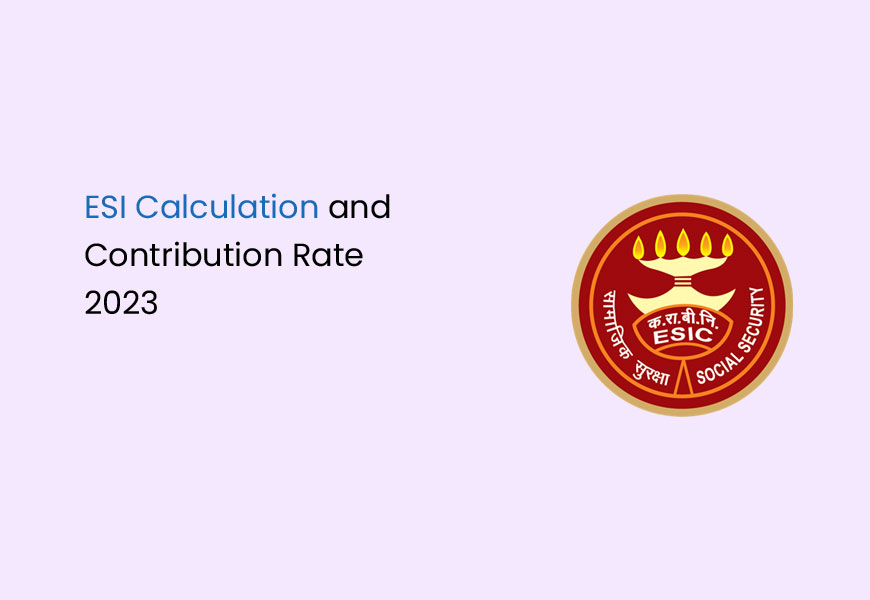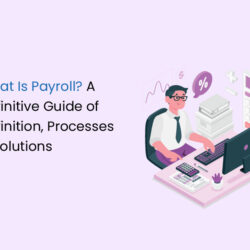The Employees’ State Insurance (ESI) is a comprehensive government health insurance scheme that is governed by the Employees’ State Insurance Act, 1948 and managed by the Employees’ State Insurance Corporation (ESIC). As per 2022 data, around 12.04 crore Indians are eligible to avail the benefits offered by the ESI scheme. This social security scheme is based on contributions from employers and employees as per the predefined ESI Contribution Rate.
This article aims to bring clarity about the concept of the ESI scheme, its contribution rate, calculations, benefits, and more. Read on to understand the government initiative better.
Wages as per the ESI Act
Wage, according to the ESI Act 1948, is the amount payable/paid to a worker as per the terms of the employment contract. The wages determine if contributions are to be made by the employer and employee into the ESI scheme and how much. These wages could be paid to workers on a contractual, weekly, monthly or even daily basis as defined in their terms of employment (implied or explicit).
However, the wages used in ESI calculations don’t include every component that is offered to the employee. It is important to the inclusions and exclusions to determine the gross salary/ wage of the employee.
Inclusions
- Basic Pay
- Dearness Allowance
- City Compensatory Allowance
- House Rent Allowance
- Meal Allowance
- Medical Allowance
- Special Allowance and Overtime
- Newspaper Allowance
- Education Allowance
- Driver Allowance
- Subsistence/ Suspension Allowance
- Interim Relief
- Attendance Bonus, etc.
Exclusions
- Entertainment Allowance
- Leave Encashment
- Compensation for Retrenchment
- Gratuity
- Deduction for Health Insurance Premium
- Tax Deductions
- Annual Bonus
- Annual Commission
- Petrol Allowance
- Travel Allowance
- Service Charges
- Savings Scheme
- Commissions to Dealers/ Agents
Benefits for ESIC Member
There are multiple advantages to signing up for the Employee’s State Insurance Scheme. We have listed down a few for you below:
- Sickness Benefits: You are obligated to receive 70% of your pay, if you’re ill and can’t work due to a certified illness lasting up to 91 days in a year.
- Medical Benefits: You and your family members are covered for medical expenses.
- Maternity Leave: Pregnant employees receive paid leave to ensure a healthy pregnancy.
Job-related Accidents: In case of job-related injuries, you’ll get 90% of your wages if you’re temporarily disabled and unable to work. - Permanent Disability: If an injury causes permanent disability, you’ll receive 90% of your wages monthly, based on the extent of your earning capacity loss, certified by a Medical Board.
- Job-related Demise: If the unfortunate happens and you pass away on the job, your dependents receive 90% of your pay every month for their lifetime.
- Funeral Expenses: In the event of a funeral, we cover expenses up to Rs.15,000.
ESI Contribution Rate
The ESI rate denotes the percentage of monthly wages that the employer and employee must contribute to the ESI scheme to enjoy its many benefits. The employer must deduct the employee’s share from their monthly wages paid/ payable. The employer must then add their own monthly contribution as per the ESI Contribution Rate and deposit the sum total of both contributions into the respective employee’s ESI account.
Every factory/ establishment with 10 or more employees (in some cases with 20 or more employees) must register with the ESIC and provide ESI to all their employees, including direct and contract employees, trainees, casual labourers and so on. This is a statutory compliance necessity in payroll for all employers as defined in the ESI Act.
The Government of India fixes the ESI rate for contributions by employees and employers, and the ESIC declares the rate. These ESI Contribution Rate for contribution are revised from time to time by the Government to reflect the changing economic, labour market and policy requirements.
The ESI Contribution Rate was changed in 2019 by the Government of India, lowering it to expand the reach of the ESI scheme and make it accessible to informal workers and those with meagre incomes.
The ESI Contribution Rate of contribution from 1997 to 2019 was as follows:
- Employees’ Share: 1.75% of the gross wages payable/paid
- Employers’ Share: 4.75% of the gross wages payable/paid
ESI Contribution Rate – 2023
The government decided to slash the total ESI rate in June 2019. The current ESI Contribution Rate of contribution (as of May 2023) is as follows:
- Employers’ Share: 3.25% of the gross wages payable/ paid
- Employees’ Share: 0.75% of the gross wages payable/ paid
Impact of ESI Contribution Rate Change
The reduction of the ESI Contribution Rate by the government has ushered invaluable benefits for both employees and employers.
The reduction of the ESI rate reduces the financial burden on the employers. Reduced statutory deductions will lead to lowered costs and, therefore, improved viability of the business. The reduced rate of employer contribution has a direct impact on the ease of doing business. It will also ensure better compliance with the statutory requirements from the employer’s end.
From the employee’s perspective, the rate reduction by the government makes the ESI scheme accessible to more workers, especially in the lower income brackets and those engaged in informal work. Further, it will bring substantial relief to workers who will have more disposable income while also being able to access quality healthcare and the whole host of benefits offered by this government insurance scheme.
How to Calculate ESI (Employee State Insurance) Contribution?
To calculate ESI, you must calculate the gross wage earned by each employee for the specified period first. To find the gross wage, you must add/ keep inclusions such as bonuses, commissions, dearness allowances, meal allowances, etc., to the basic pay. You must deduct exclusions such as travel allowances, gratuity, service charges, tax deductions, etc.
Once the gross wages are calculated, you should apply the ESI Contribution Rate to find the employer’s and employee’s contribution. The sum of these contributions will be the total ESI amount for that employee. The monthly total contributions should then be deposited in the employee’s ESIC account before the 15th of the following month.
ESI Calculation Formula
Total ESI Contribution = Employer’s Contribution + Employee’s Contribution
To grasp the nuances of ESI contribution, let’s consider the case of Mr Anuj, an employee in an ESI-eligible establishment. Anuj earns a monthly wage of INR 15,000. Here’s how the contribution towards the Employee State Insurance Scheme breaks down:
Employer Contribution = ₹15,000 x 3.25% = ₹487.50
Employee Contribution = ₹15,000 x 0.75% = ₹112.50
Total ESI Contribution = 487.5 + 112.5 = ₹600
Eligibility for ESI Coverage
Employees working in establishments/ factories with 10 or more employees are eligible for ESI coverage. However, there is a threshold salary limit for employees to be covered under the scheme. Prior to 2017, the threshold wage limit was Rs. 15000. In 2017, an Amendment to the Act increased the threshold limit to Rs. 21,000 (Rs. 25,000 for persons with disabilities). All employees earning up to the threshold limit are covered by the ESI scheme.
Even employers who are not mandated by the law can voluntarily extend ESI benefits to their employees as it improves employee health, productivity, output and retention.
How to Check the Claim Status Of ESI Online?
You can easily check the claim status of ESI. Here are the steps:
- Open the UMANG App on your smartphone (or download it if you haven’t).
- Search for ‘ESIC’ and select ‘Claim Status.’
- Log in using your phone number, and the OTP sent to your phone.
- Enter your IP number or ESIC Insurance Number and click ‘Get OTP.’
- Enter the OTP received on your reference phone number and click ‘Submit.’
- If you’ve made any claims, you can view the status. You can also use advanced search options to find specific details.
Returns Registration and Filing of ESI in Salary
Any employer that is covered by the Employee State Insurance Act 1948 Act must also be registered with the ESI so as to file returns and pay the contributions for ESI. The process is rather easy and is as follows:
- Document Preparation: Employers should gather all necessary documents for future reference.
- Registration: Register on the ESIC website and fill out Form 1 to officially register your establishment.
- Unique Number: ESIC will verify your details and issue a unique 17-digit number. This number is essential for all official filings.
- Employee ESI Cards: After registration, each employee will receive an ESI card containing the details, provided by the employer.
- Online Payments: Employers can easily pay the monthly ESI contributions online through the ESIC website using e-Challan.
- Timely Payments: Ensure contributions are paid to ESIC online on or before the 15th of every month. It’s crucial as these contributions greatly benefit employees. However, please be aware that the rules for non-payment or delayed payment are strict, so it’s essential to meet the deadlines.
Following these steps ensures employees receive the benefits they deserve under ESI, making the process smooth and beneficial for everyone involved.
After you have successfully registered your establishment, you can file for returns online easily. There is a procedure that must be followed to file EDI returns, it is as follows:
- Log in to the official ESIC website using the provided credentials after successful registration.
- Access various actions like modifying employee details or reporting accidents.
- Choose the ‘File Monthly Contributions’ option.
- Enter month, year, and contribution details, then click ‘Submit.’
- After contributions, go to ‘List of Actions’ and click ‘Generate Challan.’
- Download the generated challan for future reference and inspections.
- Note the submission deadlines: 11 November for April to September and 11 May for October to March ESIC returns.
Also Read: ESI Registration: Process, Benefits, Required Documents
ESIC Collection
An employer is responsible for paying his contribution for each employee and deducting employee contributions from wage bills. Furthermore, the employer must pay the contributions to the Corporation within 15 days of the last day of the calendar month in which the contributions are due.
The Corporation has authorised certain State Bank of India branches and a few other banks to accept payments on its behalf.
Are There Any Consequences for Non-Payment or Late Payment of Employee Contributions?
Yes, there are consequences to the non-payment or late payment of employee contributions to the ESI scheme. When the amount is deducted from an employee’s pay, it is entrusted to the employer, making the employer responsible for depositing it with ESIC.
- Non-payment or late payment of an employee’s contribution is a punishable offence under the ESI Act.
- Offences like non-payment, late payment, or falsifying payments can lead to imprisonment for up to three years (not less than one year) and a fine of Rs 10,000 under the ESI Act.
- Employers are also liable to pay a simple interest at the rate of 12% per year for each day of delay or default in payment.
Contribution Period and Benefit Period
To comprehend its workings, it’s essential to grasp the fixed contribution and benefit periods, delineating when contributions are made and when the accrued benefits can be availed.
Contribution Periods
The ESI contribution period is neatly divided into two distinct 6-month phases. The initial stint spans from April to September, with the latter half extending from October to March. Within these periods, both employers and employees are mandated to make monthly ESI contributions. This financial commitment, fulfilled by the 15th of the subsequent month, serves as the cornerstone for the scheme’s functionality.
Throughout the contribution period, the contributions, diligently made by both parties, find their way into the employee’s ESI account. These contributions denote fiscal responsibility and make the beneficiaries eligible for an array of benefits under the ESI.
Benefit Periods
Mirroring the contribution periods, the benefit periods are also organised in 6-month blocks. The initial benefit stretch spans from January to June, while the latter half encompasses July to December. The benefits extended to employees are directly proportional to their contributions made during the corresponding contribution period. This means that an increase in one’s salary leads to a subsequent elevation in the benefits they stand to receive, a reassuring reflection of their dedication and hard work.
Threshold Limits and Disqualification
If an employee earns more than a certain limit, they still contribute. This ensures a safety net even when times are good. But, if their earnings consistently exceed the limit, they might not qualify in the future.
Basically, ESI follows a simple idea: what you put in now helps you in the future. It shows how both employers and employees care about each other’s well-being at work, providing security and peace of mind.
In the big picture of work benefits, ESI isn’t just a rule; it’s like a shield. It gives financial security and makes people feel safe. This partnership between contributing and getting benefits shows how much everyone cares about the workers’ well-being.
In Conclusion
Understanding the intricacies of ESI contribution rates and calculations is essential for both employers and employees. While navigating the complexities of these contributions might seem daunting, technological advancements have simplified the process.
One such user-friendly tool is our app, TankhaPay, a groundbreaking invention designed to assist employers in managing ESI contributions effortlessly. With our intuitive interface and streamlined features, TankhaPay not only simplifies ESI calculations and execution but also helps with EPF benefits. Employers can now navigate the intricacies of these schemes with ease, ensuring compliance and the well-being of their workforce.
Incorporating TankhaPay into your business operations would save time and effort while also fostering a sense of confidence in handling ESI and EPF contributions. Embracing such innovative solutions not only ensures legal compliance but also reflects a commitment to the welfare of employees, creating a harmonious work environment for everyone involved. Get a callback from us today!
FAQs of ESI Calculation
Can ESI Contributions Be Withdrawn?
No. The benefits provided by the ESI scheme cannot be withdrawn as funds for personal use. The contributions are premium payments against which health coverage and other benefits are provided by the Government.
Who determines the contribution rate for the ESI scheme?
The contribution rate for the ESI scheme is set by the Government of India. These rates are periodically revised. As of June 2019, the contribution rates were reduced. In the present economy, the individual employee's contribution rate is 0.75% of wages, and his or her employer contributes 3.25% of pay intervals.
If an employee's wages exceed Rs.21000 in a month, are they still covered under the ESI scheme?
If an employee's wages exceed the Rs.21000 limit after April or October for the respective contribution periods, the employee remains covered under the ESI scheme until the end of that contribution period. Contributions are deducted and paid based on the total wages earned. After the contribution period ends, if the employee’s salary continues to be above Rs. 21000, they will no longer be eligible for ESI.
Where can I find information about the current ESI contribution rate?
You can find the details of the current ESI contribution rate on the official website of the Employees' State Insurance Corporation (ESIC). The government publishes the updated contribution rates for employees and employers on the website.
What are the different benefits provided under the ESI scheme?
The ESI scheme offers various benefits to employees, including medical benefits, sickness benefits, disablement benefits (temporary and permanent), dependent benefits, maternity benefits, confinement expenses, funeral expenses, and unemployment allowance.
What is an ESI card?
An ESI card, also known as a Pehchan card, is a magnetic card issued to each insured person under the ESIC scheme. This card is necessary to avail of various ESIC benefits, including hospital payments.
How can I download an ESIC Pehchan card?
To obtain an ESIC Pehchan card, the employer needs to download the counterfoil from the ESIC portal and provide it to the employees. The employees must then affix their photographs and signatures on the counterfoil and submit it to the nearest ESIC office. Employees must also bring their dependents to the ESIC office for fingerprint capturing. Once the fingerprints are recorded, the ESIC office will send two ESI cards to the employees via courier.
What is the ESIC contribution rate for outsourced employees?
The ESIC contribution rate is the same for all employees and is currently 0.75% of salary. The total ESI contribution rate is 4%, and the employer pays the remaining contribution of 3.25% as per government norms.
Is ESIC applicable for a salary of 21000?
All employees with a salary less than or equal to Rs. 21000 are eligible to get ESIC. This limit is Rs. 25000 in the case of persons with disabilities.





















